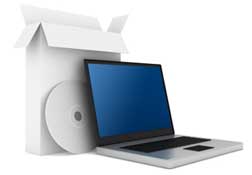 In most industries, and even non-business related activities, there are tools you can use to compare how you’re doing to some compilation of data from other similar ventures. While I believe comparative analysis is certainly something that should be considered, a more important measurement is how you are doing in your own world today and your individual trends over time.
In most industries, and even non-business related activities, there are tools you can use to compare how you’re doing to some compilation of data from other similar ventures. While I believe comparative analysis is certainly something that should be considered, a more important measurement is how you are doing in your own world today and your individual trends over time.
I’ll share a few personal and business examples of average statistics that aren’t necessarily good numbers to shoot for. A golfer on the PGA tour usually puts a new ball in play every few holes of a golf tournament because he hits the ball with such power that he actually wears out the ball, while the average golfer should be able to play the same ball for at least a couple rounds. I, too, put a new ball in play every few holes, but it’s because I either hit something that scuffed it up, or it’s too deep in the woods or the pond to find. Don’t quote me on this because the facts may be a little fuzzy, but I once read an article that, on average, most serious private aircraft accidents happen when the pilot has around four hundred hours of flying experience. Of course, this is not a statistic that most pilots want to aspire to.
On the business side, there are industry measurements that a software company like Red Wing Software should spend about sixteen to eighteen percent of its budget on development. Again, that might be something worth measuring against, but we as a company need to look at our particular situation and determine if that is the right allocation for us. Another example would be comparing a particular business ratio against a specific industry benchmark. While that individual indicator might be way off, you should look at several indicators and determine if there is an anomaly in that one measurement and everything else is in line. It might be because of some significant difference in your particular business.
When doing business (or life) comparisons, make sure you look at all the facts that could affect the validity of the measurements, and make appropriate decisions. I personally prefer to look at trends and make certain they are headed in a positive direction. I’m down to about five new golf balls per eighteen-hole round.
 We recently conducted a survey to learn more about what business people experience when switching from one accounting software program to another. Of the respondents who had made the decision to switch software, 66% of them said they did so because they needed more advanced features. At Red Wing Software, we do find many customers need more robust features that can handle their accounting in a way that helps their business run more smoothly. Here are some of the most common features companies begin to need as they grow.
We recently conducted a survey to learn more about what business people experience when switching from one accounting software program to another. Of the respondents who had made the decision to switch software, 66% of them said they did so because they needed more advanced features. At Red Wing Software, we do find many customers need more robust features that can handle their accounting in a way that helps their business run more smoothly. Here are some of the most common features companies begin to need as they grow.
Manage multiple companies
Many of the basic accounting software programs put a limit in the number of companies/entities you can have and manage in your accounting software. This is fine at first, but as you grow, you may add companies and may want to manage and track their financial information separately. Many of these customers turn to Red Wing Software since our products offer the ability to set up and manage unlimited companies/entities. The ability to do reporting for one, all, or a combination of your companies which is often not found in more basic products , is another feature offered by Red Wing Software products.
Increased data capacity
If your system is getting bogged down, running slowly, crashing often, or simply performing poorly, you may be reaching that system’s data capacity. This is typical of basic systems after you have used them for some time. Many things can contribute to filling up a system’s data capacity: the number of transactions, inventory items, or even the amount of history stored in the system. Most basic systems place a finite limit on capacity of those items, cutting you off abruptly once that limit is reached. (For instance, you can only enter 20,000 inventory items or two years of history, etc.) Red Wing Software offers products that have unlimited storage capacity, where a finite number is not placed as a limit on any of those items. (Note: Please keep in mind that, although no finite limit is placed, hardware capacity may be reached someday, if used for long enough.)
Better/custom reporting
What good is an accounting software system if you cannot pull out the information you want and need? The profitability of your business depends on it. Whatever information you were able to pull out at the start may not be enough for you, the management team, or third parties, such as banks, who are requesting information from you. The inability to get information the way you want or need it is a good sign you need a better accounting software program. Red Wing Software products do offer a wide range of standard reports, and also the ability to add, remove, and move around fields of information on reports. You can also name and save your reports in a list of favorites so they are easily accessible when you need them!
These are some of the most popular reasons we find companies turning to Red Wing Software products as they outgrow their older, more basic accounting software. There is a long list of reasons businesses outgrow their accounting software, and surely your reasons are unique. If you have outgrown your software and need something new, give us a call at 800-732-9464 or e-mail info@redwingsoftware.com.

With the constant growth in technology, many business processes are becoming more streamlined. Payroll processing that used to be done over several days with paper and pencil can now be done in minutes with the right software. Since the inception of companies using payroll software to process payroll and write checks, even more tools have become available to make the process easier, more accurate, and more efficient. Here is a list of today’s must-have payroll software tools for a business to improve payroll processes.
- Direct Deposit: This tool allows a business to transmit pay data electronically directly into employees’ bank accounts without printing pay checks. Information is usually transmitted from the payroll software to the bank accounts securely in a bank-friendly format. By using direct deposit, companies can save money on pay check processing time and supplies. Many employees also prefer direct deposit because it saves them trips to the bank and also eliminates the problem of lost pay checks.
- Electronic Tax Filing: Whereas mandatory end of year tax filing has traditionally been done on paper, today’s payroll software programs have built-in tools to make electronic tax filing (“e-Filing”) simple and accurate. By filing taxes electronically, a business can eliminate the cost of forms. Tools are now even available to allow employees access to W-2 forms online instead of having to wait for the paper version to arrive by mail. Filing electronically can also reduce the stress of tight, end of year deadlines because transmission is instant.
- Time Clock: If employees are required to fill in time sheets, re-entry into a payroll software system leaves room for entry errors and also duplicates efforts. By implementing an electronic time clock, a business can remove the margin for error, keeping employee pay checks accurate. Most time clocks are simple to use, and pull information in a standard file format so that time clocks will operate with most payroll systems. Most payroll software systems allow for mapping of information to be pulled in from the time clock to the software.
- Advanced Earnings Matrix: With an advanced earnings matrix (which may go by various names depending on software developer), a company sets up each employee with a separate rate for all ways they can be paid. For example, if a company tracks pay by department and by profit center, each employee record is set up with a pay rate for every department and profit center combination in which they may work and be paid for. All earnings and deductions are calculated accordingly when time is entered. An advanced earning matrix saves time by drastically cutting down on the number of pay codes that are necessary to track employee pay. Instead of using a long list of codes, time is simply entered by choosing the factors they set up.
- Custom Reporting: Do not underestimate the fact that your company is unique. Some payroll systems now pay tribute to this fact by offering simple tools which allow the user to customize reports, and to name and save them for later use. By using custom reporting, a business can easily see pay data in a timely manner, and filter out only the information that is important to their own organization.

Internet article marketing is a marketing activity, whereby you promote products and services by writing articles, and sharing them on article submission Web sites. When you submit articles on the Web at article submission sites, they are indexed by the search engines and found by people searching for what you are writing about. This brings clicks to your Web site, and also positions you as a leader. It also helps your own Web site’s popularity by providing a back link to your Web site. Here are a few tips on how to get started with internet article marketing.
-
Choose a topic and focus on a keyword.
You might be asking yourself, “What on earth will I write about?” Don’t worry; nearly everybody starts out by asking that question! But really, you or somebody at your company has a whole wealth of information, just waiting to be shared with those who need it and search for it out on the Web. Think about what your customers or prospects would truly want to know or learn about. If you own a catering business, you could write about ten ways to plan the perfect gathering. If you have a heating and air conditioning business, you could write about how to drastically reduce your heating bill in the winter. You know what your customers would find useful, so write about that! Don’t try to write a novel; people lose interest quickly on the Web! So choose a fairly narrow topic: perhaps a keyword you know is popular and that you already focus on for a page on your Web site. (Note: “keyword” in this case can mean a set of 2-3 words, such as “accounting software”, etc.)
-
Make it about 500 words.
You definitely want the search engines to index and ‘like’ your articles. And these days, search engines (and particularly Google), don’t want to see a puny, short blurb, but instead an article with some real meat to it. Making the article 500 words, and surely no less than 400 words, gives your article a better chance at ranking with the search engines. (Tip: many article submission sites do actually have a minimum word count for this reason, and won’t allow shorter articles than their minimum.)
-
No sales pitches.
While it might be tempting to write articles all about why your product is so great, just don’t go there! People would much rather read about something useful than a sales pitch. So instead of writing about yourself (or your company’s product features), choose a topic that could actually be helpful to your reader.
-
Try ezinearticles.com
There is a wide variety of article submission sites on the internet, and you can submit your articles to most of them for free. I suggest starting out by signing up for an account with ezinearticles.com, and submitting a few articles at their Web site. Their tools make it easy to submit your articles, and ensure your keyword density and word count are optimum for the search engines. Plus you can easily access great statistics once your articles are live, and you also get a monthly report showing views, click through rates, and more for your articles.
Internet article marketing can bring traffic to your site and can also help in the search engine optimization for your Web site. Use these tips and start cranking out that first article today!